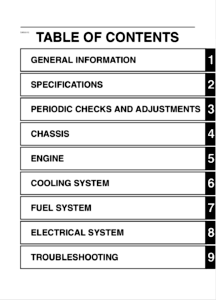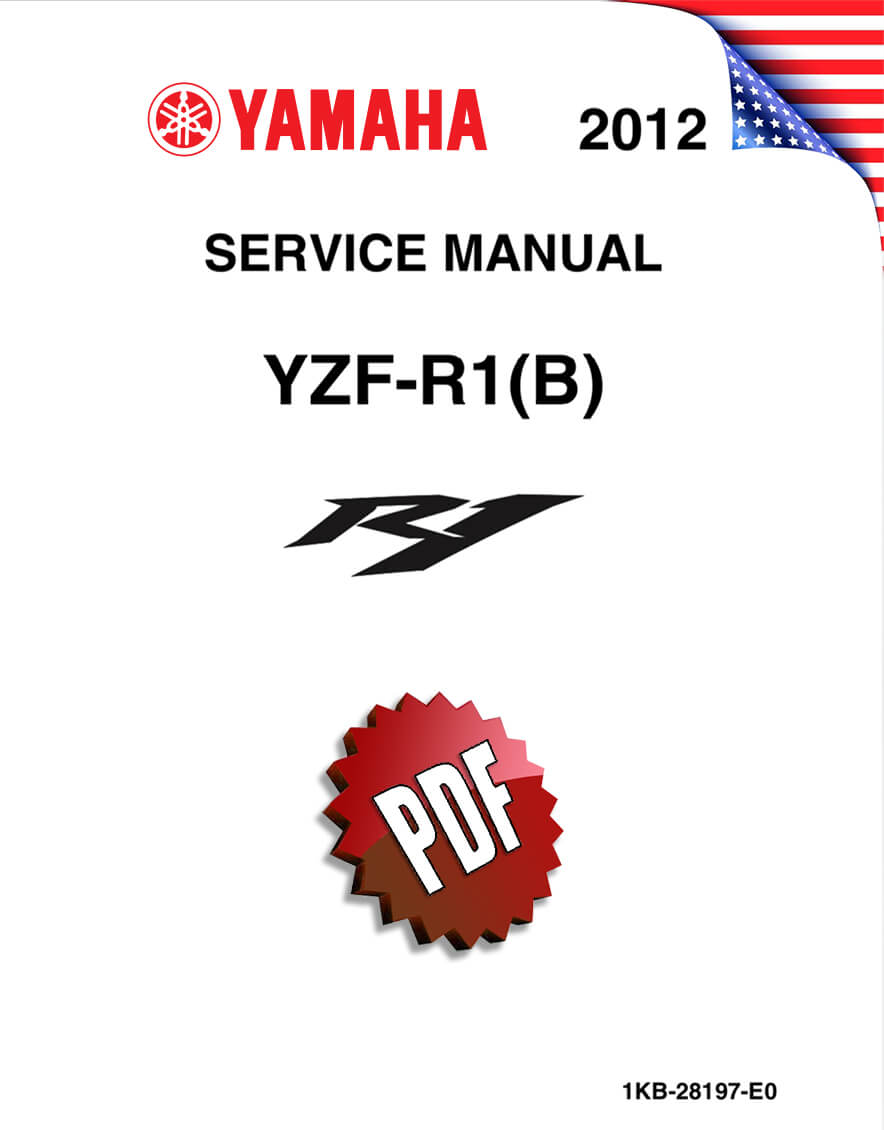Complete PDF version of the Service Manual for the Yamaha YZF-R1 (B). A MUST for every R1 owner.
Download: Immediately after payment!
OEM Original factory workshop manual.
Models covered by this manual: 2012-2014
Number of pages: 556 pages
Table of contents:

This PDF repair manual can be downloaded right after the payment process in complete, on the device of your choice. You will also receive the download link by email along with your receipt.
We do not offer printed manuals, for the following reasons:
- it is more eco-friendly to use a digital version
- your manual never gets dirty or greasy
- you can always choose to print the specific page(s) you need to work on your bike
- you receive your manual immediately after payment
- it is searchable

Yamaha YZF-R1
Yamaha introduced the YZF-R1 after reworking the Genesis engine to make it more compact by lifting the gearbox input shaft and allowing the gearbox output shaft to be positioned underneath it. Other automakers adopted the’stacked gearbox.’ The engine was made significantly shorter by compacting it, allowing the wheelbase to be lowered. Because of the improved center of gravity, the frame design was able to position the weight of the engine in the frame to help handling.
The swingarm could be lengthened without jeopardizing the entire wheelbase, which was just 1,385 mm (54.5 in). The engine was supplied gasoline by four 40 mm Keihin CV carburetors. It was outfitted with KYB upside-down 41 mm front forks and 300 mm semi-floating disk brakes. The instrument panel was electronic, and it had a self-diagnosis system and a digital speed readout. Yamaha’s Exhaust Ultimate Power Valve (EXUP) was employed in the exhaust system to manage the exhaust gas flow and enhance engine power generation at all rpm. This resulted in a high-powered, high-torque engine. The Yamaha YZF-R6 superbike was released in 1999 as the 600cc version of the R1.
Aside from paint and cosmetics, the 1999 R1 experienced very minimal alterations. A revised gear change connection was also included, as was an increase in the length of the gear change shaft. The reserve fuel tank capacity was lowered from 5.5 to 4.0 L (1.21 to 0.88 imp gal; 1.5 to 1.1 US gal), although the overall fuel tank capacity remained constant at 18 l (4.0 imp gal; 4.8 US gal).
2009-2014
Yamaha revealed in late 2008 that an all-new R1 will be released in 2009. With its cross plane crankshaft, the new R1 borrows engine technology from the M1 MotoGP bike. Crossplane technology separates each connecting rod by 90°, resulting in an irregular firing interval of 270°- 180°- 90°- 180°. The crossplane crankshaft was used for the first time on a production sportbike, the 2009 R1. The power delivery is comparable to that of a 90° V4 with a 180° crank, such as the Honda VFR800, and very similar to that of the Yamaha V-Max, which has been praised for its exhaust sound. Yamaha promises the bike will provide the rider with “two engines in one,” the low-end power of a twin and the speed of an inline four. The Yamaha Chip Controlled Throttle is still there on the 2009 model, as it was in earlier generations of the R1 (YCC-T).
D-Mode Throttle Control Valve Mapping, which allows a rider to choose between three unique maps based on the rider’s environment, was also incorporated on the 2009 model. Each mode of operation modifies the YCC-T characteristics, affecting how the R1 responds to rider input. The first option is Standard Mode, which provides performance for a wide range of driving situations. The second mode is “A,” which provides the rider with greater accessible power in the low to mid RPM range. The third mode is “B,” which is a dialed-back version of the preceding mode meant to ease throttle response in bad weather and heavy traffic. The rider operates D-Mode throttle control by pressing a forward mode button near the throttle. The instrument panel is more complete than previous versions, and the Yamaha YZF-R1 model from 2009/2010 had a gear indicator as standard.
The R1’s overall handling was enhanced via improvements to the frame and suspension. For the 2009 R1, a redesigned subframe made of magnesium was developed to reduce weight and help in mass centralisation. The 2009’s rear shock absorber has variable speed damping as well as an easily adjustable pre-load through a screw adjustment. In contrast to prior years’ models, the rear shock now links beneath the swing arm through a separate connection. Yamaha installed an electronic steering damper to improve overall handling and safety.
The front has the same traditional R1 form, but the air intake placement and headlight design have been revised on the 2009 model, employing only projector lamps and rerouting ram air tubes adjacent to the lights using the new-found design space within the nose cone.
Motorcyclist magazine recorded a 0 to 14 mi (0.00 to 0.40 km) time of 10.02 seconds @ 144.23 mph (232.12 km/h) and fuel usage of 25 mpg-US (9.4 L/100 km; 30 mpg-imp) when testing the 2010 model year on a tri-oval racetrack. According to Motorcycle Consumer News, the tested highest speed was 176.7 mph (284.4 km/h).
The Yamaha YZF-R1 featured traction control, a new upper cowl (bike’s nose), and a special edition 50th Anniversary R1 in 2012. The special edition color is inspired by the MotoGP bike that won the Assen TT. Yamaha’s presence in MotoGP is commemorated with this special edition. This edition was limited to 2000 copies.
Source: Wikipedia

